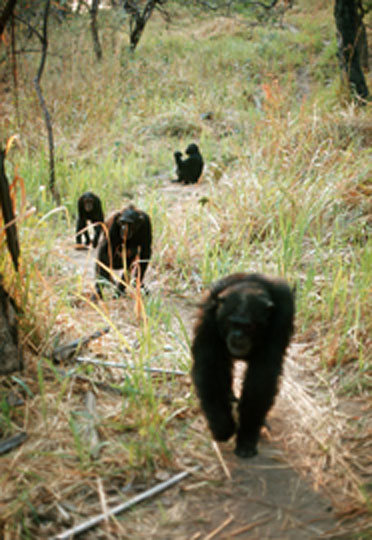Territorial Behavior

Credit- Hugo van Lawick
Until 5 years of age,
male and female chimpanzees spend most of their time with
their mothers. As they grow older, male chimpanzees follow
along with adult males patrolling the periphery of the
community. Members of the patrol look for members of
another community that strayed into their area. They move
cautiously across the ground in a tight group formation.
They inspect the ground and leaves and tree trunks are
sniffed for signs of a stranger. Patrol members stop
frequently to climb tall trees, gaze, listen, and look
over the area of a neighboring group. The chance discovery
of a fresh night nest causes alarm. The nest is destroyed
while making intimidating gestural, vocal, and postural
displays. If a stranger is not encountered the patrol
party returns to its home territory.
If the patrol runs into
strangers, with roughly equal numbers of males, a vigorous
display with vocal threats such as pant-hooting, roaring
pant-hoots and waa-barks will ensue. The excited
chimpanzees hurl rocks, leaves, and branches. They also
drum on tree trunks, and stamp and slap the ground. If the
other side responds, a series of wild displays will occur.
Most of the time, after making a lot of noise, one party
will retreat to their core area.
If the patrol encounters
a stranger, aggression may occur. For example, a prolonged
and violent territorial dispute occurred in Gombe, when
the large community of Kasakela attacked the smaller
community of Kahama. The result was the devastating
destruction of the little community from several bloody
battles.
Captive Chimpanzees
Chimpanzees living in
zoo enclosures are also territorial, preferring some areas
of the exhibit to others. Dominant chimpanzees may occupy
favored areas of the enclosure while those low in rank
remain at a distance. In some cases, fights over specific
areas and the right to favorite females occur. Some zoos
allow the chimpanzees free access to indoor and outdoor
exhibits to lessen aggression. Still other zoo chimpanzees
living together appear to cohabitate without any serious
problems.

